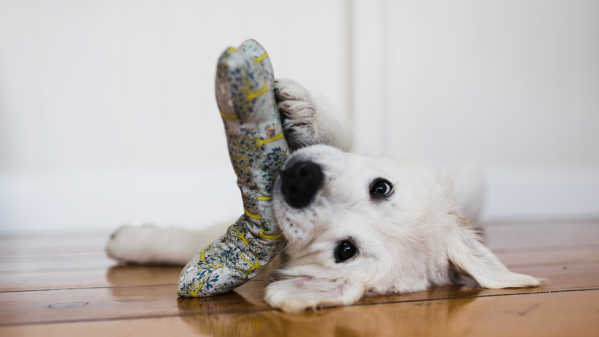There are few joys greater than bringing a new puppy into the house. But as exciting as a new pet can be, a puppy is a lot like a new baby and will go through the same types of growing pains. One such growing pain is puppy teething, and while they will be uncomfortable, we can help them a great deal if we know the signs to look out for.
When do puppies start teething?
Puppy’s first teeth begin to come in around 2-4 weeks. However, just like with human children, it can vary a little. “At around 5-6 weeks a puppy will usually have 28 baby teeth and this is where a nursing mom starts to think twice about allowing those sharp needles near her sensitive belly,” says Dr. Ken Sieranski, Director of Veterinary Medicine at Hearts Alive Village in Las Vegas. This is when weaning begins.
When do puppies start losing their baby teeth?
Puppies begin to lose baby teeth at around 12-16 weeks. This is an exciting development because these teeth leaving means their mouths are making room for their adult chompers, according to Dr. Sieranski.
When do dogs stop teething?
But rest assured this time will not go on forever. “At about 6 months of age, a puppy should have about 42 adult teeth, which is 10 more than humans get,” said Sieranski. Usually, the painful part of teething is over at about 4-5 months, but if you aren’t careful to manage the behavior of chewing, it can last for another couple of years. So be watchful and take care of that puppy!
Signs your puppy is teething
Whining and crying
Slower eating
Drool
Increased chewing
Irritability
Swollen or bleeding gums
If you have ever been around a teething baby, you know the process is painful. Although puppies may whine and cry like a baby, many times the signs are not as obvious. “Because of the discomfort in their gums and mouths, they may eat slower, drool, and try to chew on anything, including you,” said Dr. Sieranski. Ouch!
How to manage a puppy's teething pain
Remember that your puppy is going through an uncomfortable stage in their development. Never punish your puppy for chewing to try and relieve the pain in their mouths. Rather: “Offer to replace the bad things to chew with good ones,” says Dr. Sieranski.
Use puppy safe chew toys
Puppy safe chew toys are always the best solution. “Some have a nubby or textured exterior to give that extra stimulation the gums are crying for,” says Dr. Sieranski. Freezing those toys can provide even more relief.
Offer a frozen banana or carrot
A frozen carrot or banana can be good for a teething puppy and give nutrients at the same time. Always monitor your puppy with any toys or treats.
Try meds or natural pain relievers
It’s always safest to go natural and pharmaceutical free. “Finding creative ways to calm discomfort and inflammation by delivering soothing cold and frozen treats and toys is recommended,” says Dr. Sieranski. However, there are some teething gels made for dogs that contain natural products such as chamomile, peppermint and clove oil which may help. It’s important to never use human products on your puppy.
Bully sticks
Bully sticks are fully digestible (unlike rawhide) and last a long time. “Antlers and bones are too hard for puppies' teeth and can break them. Bully sticks won’t chip their teeth,” says Dr. Sieranski. You buy them in sticks so they cannot possibly swallow them. Let your puppy chew on one end while you hold the other. It’s a great way to spend positive time with your baby, give them pain relief, and positively reinforce chewing on the right thing!
Cooling teethers for puppies
These toys are made of durable material and are shaped like bones or rings (or a few other attractive objects. They can be placed into the freezer and give hours of cooling relief,” says Dr. Sieranski can also be used as a fun fetch toy.
Training tips for puppy teething
Puppy biting is very normal. It’s a behavior you should expect to manage until they are 6 months old. That being said, all puppies are individuals, which means they can have very different behaviors even within the same litter. Stay patient above all. You may need to try a few different approaches before you can celebrate victory!
1. Always be ready to offer an alternative to your hand or any other item you don’t want puppy biting.
2. Remember it’s more powerful to reward the positive moments than to punish the negative. “Be ready to positively reinforce with high value treats and loving praise,” explains Dr. Sieranski. For instance, when the puppy chooses the correct thing to chew on or licks your hand instead of biting.
3. If the puppy is seemingly uncontrollable, a small time out can interrupt the behavior, suggests Dr. Sieranski. If done consistently, it will help the puppy understand that playtime stops if biting starts.
4. A liquid treat dispenser can be used to encourage your puppy to lick instead of bite, adds Dr. Sieranski. It’s small and easy to carry around in your pocket. This dispenser can be filled with peanut butter, cream cheese, or baby food.
